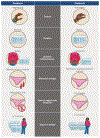Couples' decision making regarding the use of multipurpose prevention technology (MPT) for pregnancy and HIV prevention
- PMID: 35776249
- PMCID: PMC9805468
- DOI: 10.1007/s10461-022-03756-9
Couples' decision making regarding the use of multipurpose prevention technology (MPT) for pregnancy and HIV prevention
Abstract
We conducted a secondary analysis of discrete choice experiment (DCE) data from 395 couples enrolled in the Microbicide Trials Network (MTN)-045/CUPID study in Uganda and Zimbabwe to understand couple decision making around choice of multipurpose prevention technologies (MPTs) to prevent both HIV and pregnancy. Members of couples completed the same DCE, first separately then jointly, choosing between two hypothetical MPTs in a series of nine questions. Most couples either had similar preferences at the outset or had equal decision-making around MPTs (62%). Couples with male influence (17%) were more likely to use contraceptive pills with a male partner's knowledge and couples with female influence (21%) were less likely to have shared decision making about family planning. Males influenced discussion around MPT duration, side effects, menstrual changes, and how the vagina feels during sex. Decision making was relatively shared, though decisions around certain attributes were more likely to be dominated by male partners.
Keywords: Couples; Decisions making; Discrete choice experiment; MPT.
© 2022. The Author(s), under exclusive licence to Springer Science+Business Media, LLC, part of Springer Nature.
Conflict of interest statement
Figures
References
-
- Hubacher D, Mavranezouli I, McGinn E. Unintended pregnancy in sub-Saharan Africa: magnitude of the problem and potential role of contraceptive implants to alleviate it. Contraception [Internet]. 2008. Jul [cited 2021 May 18];78(1):73–8. Available from: https://pubmed.ncbi.nlm.nih.gov/18555821/ - PubMed
-
- UNAIDS. UNAIDS data 2020 [Internet]. Geneva, Switzerland; 2020. [cited 2021 May 18]. Available from: https://www.unaids.org/sites/default/files/media_asset/2020_aids-data-bo...
-
- Karim SA, Baxter C, Frohlich J, Karim QA. The need for multipurpose prevention technologies in sub-Saharan Africa [Internet]. Vol. 121, BJOG: An International Journal of Obstetrics and Gynaecology. Blackwell Publishing Ltd; 2014. [cited 2021 May 18]. p. 27–34. Available from: /pmc/articles/PMC4206830/ - PMC - PubMed
-
- Brown ER, Hendrix CW, van der Straten A, Kiweewa FM, Mgodi NM, Palanee-Philips T, et al. Greater dapivirine release from the dapivirine vaginal ring is correlated with lower risk of HIV-1 acquisition: a secondary analysis from a randomized, placebo-controlled trial. J Int AIDS Soc [Internet]. 2020. Nov 1 [cited 2021 May 19];23(11). Available from: https://pubmed.ncbi.nlm.nih.gov/33206462/ - PMC - PubMed
MeSH terms
Grants and funding
LinkOut - more resources
Full Text Sources
Medical


